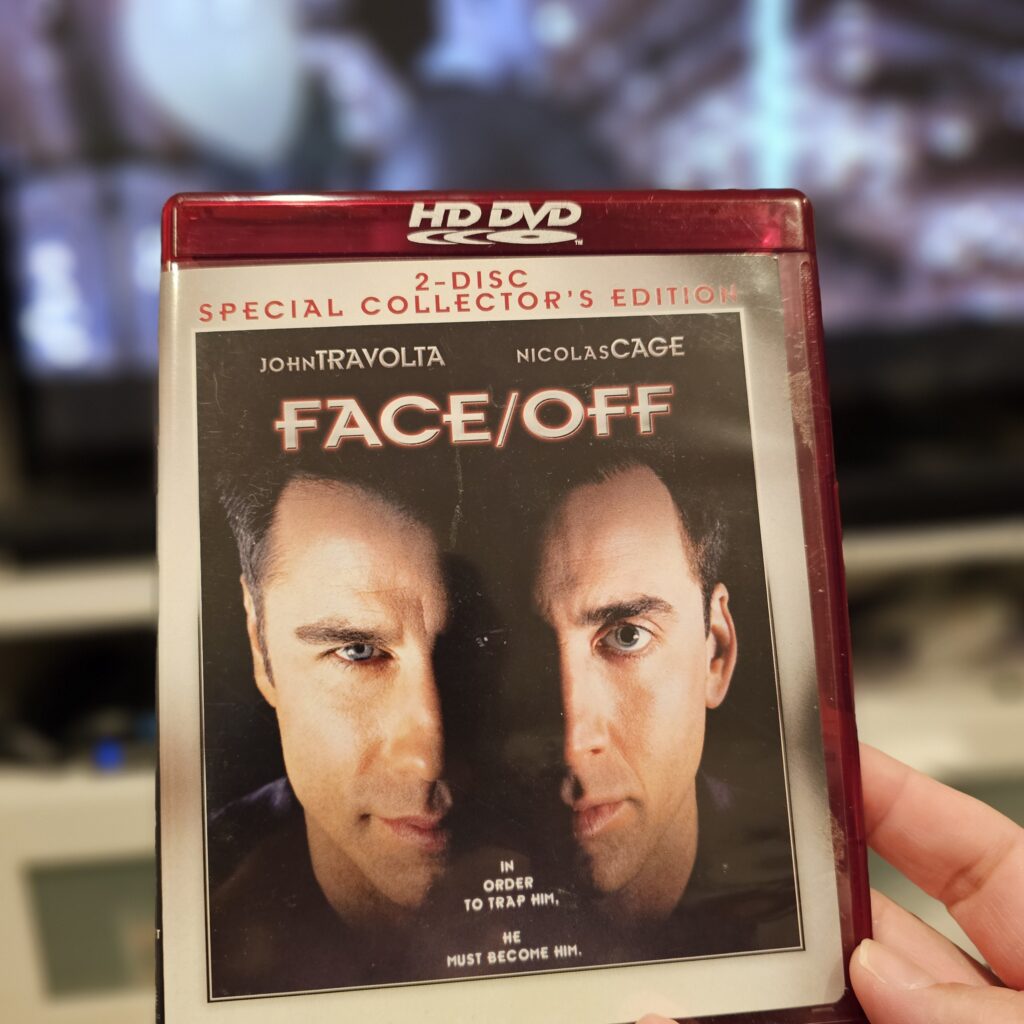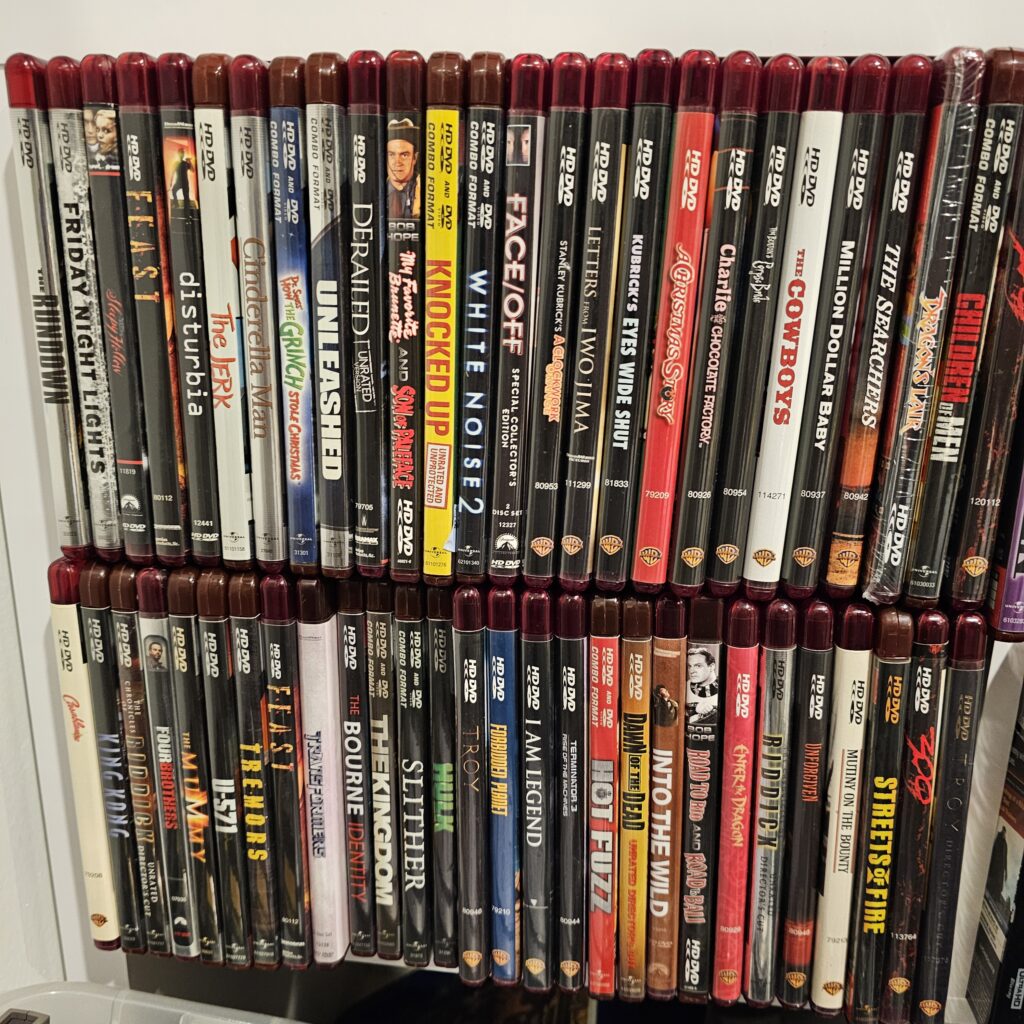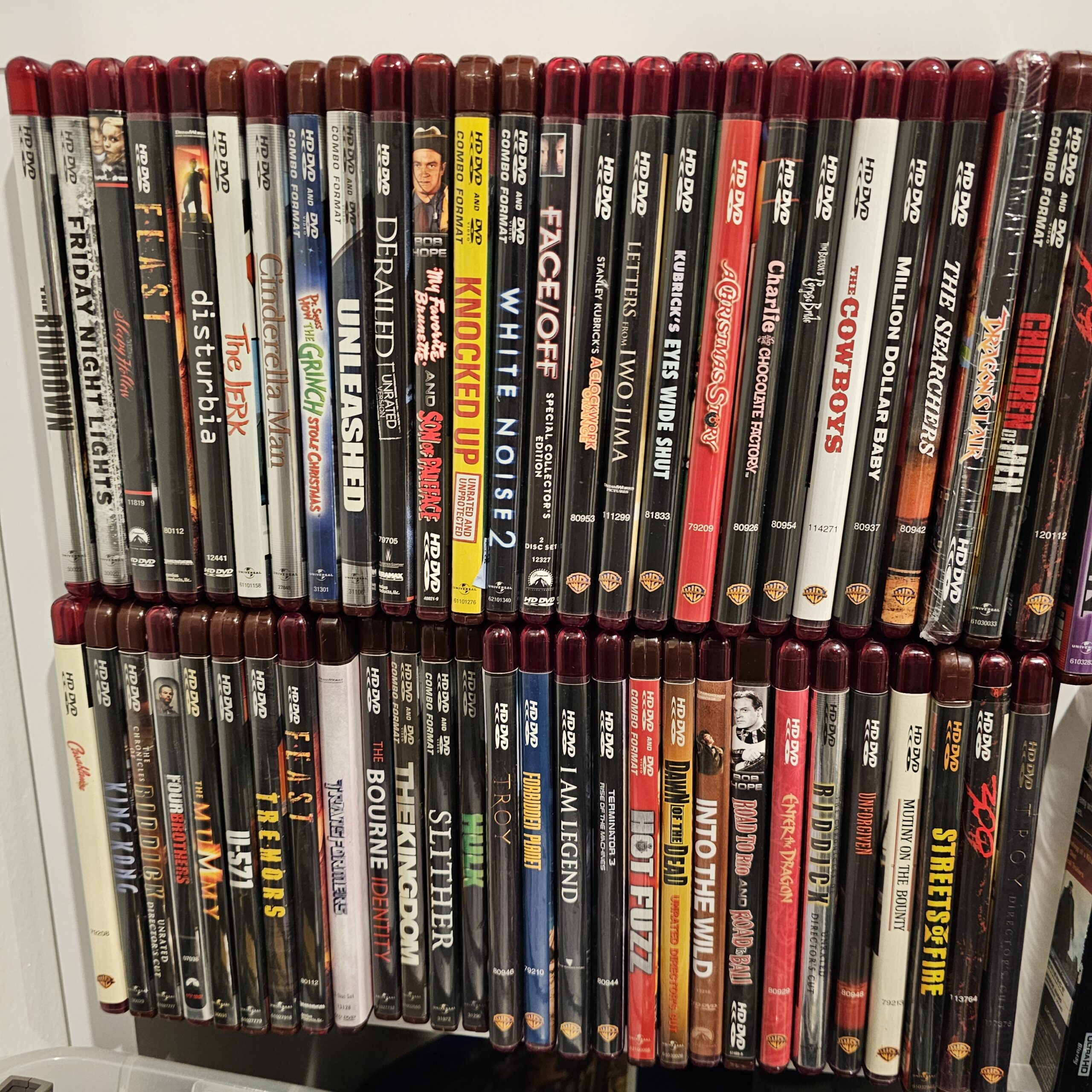
I recently picked up a trove of HD DVDs and a standalone HD DVD player off of Facebook Marketplace (damn you, Zuck!) for a cool $30. Despite having a house outfitted with 4K TVs and a sprawling selection of streaming services at my fingertips, I’ve found myself oddly obsessed with watching movies on this obsolete disc-based format over the last few months.
There’s something about acquiring a dead physical media format. It’s like taking in a stray technological dog or resuscitating someone’s forgot dream. The war long over, the battles all but forgotten, the thing can be just appreciated for what it aimed to be, warts and all.
Going through this haul of someone’s past financial blunder has been like cracking open a weird little time capsule. HD DVD was introduced to the world in the halcyon days of 2006. Its 1080p flame burned bright for a mere 2 years, fizzling out 2008.
A little background: When the high-definition (HD) home theater era arrived in the early 2000s, HD media and the HDTVs that displayed it promised a whole new ballgame for home movie viewers.
DVDs were a huge hit and migrated the masses from analog VHS tapes into a new digital realm of movie watching. HD represented the next step forward, with dramatic increases in image quality, digital sound, and the ability to serve up a bevy of special features designed to take viewer immersion into entirely new territory (more on that, and how it ultimately failed, a bit later).
While the advent of HD home cinema felt like a big step into the 21st century, it started off in a very 20th century way- with a good ol’ fashioned format war.
On one side of the ring, in blue trunks, was the mighty Blu-Ray, backed primarily by Sony and Disney. On the other, in a dark shade of crimson, was HD DVD, championed by Toshiba and supported at launch by an impressive range of major studios like Warner Brothers, Univeral, and Paramount, as well as Microsoft.
The details of this format war played out are well documented and examined elsewhere, but the long and short of it is Blu-Ray won, HD DVD lost, and the world pretty quickly thereafter kind of stopped watching movies on discs altogether.
The perks of being an old wallflower
The first time I saw HD content was in a Sears that no longer exists, when I was a broke reporter for a newspaper that no longer exists. I marveled at the crystal-clear imagery, the sleek shiny black boxes, and the remote controls with more buttons than I had ever seen. I also marveled at the price tags for all this cutting edge new high-def gear. With some quick calculations, I reckoned I could afford a nice HD setup with about 6 weeks of my salary, if I gave up trivial vices like eating and paying rent. There would be no format war for me, much to the relief of my checking account.
One of the perks of surviving to middle age is getting to watch the once unobtainable become near worthless. Being able to explore this once premium priced home media landscape for pennies on the dollar feels like being a contestant on those old game shows where people ran through stores and filled shopping carts with anything they wanted with complete abandon. Protip for the youth: if there’s something you really want but can’t afford, just give it a couple decades.
Exploring my new HD DVD horde has been fun in large part because of the quality of the movies that were top hits in 200X. I’m talking about cinematic classics like TROY, THE RUNDOWN starring a youthful Dwayne “The Rock” Johnson, who I assume will one day be president and future emperor of Earth. There’s Ang Lee’s beautiful disaster of a HULK movie, pre-Synderverse cult 300, pre-slap Will Smith banger I AM LEGEND, FRIDAY NIGHT LIGHTS, and so much more.

The main thing that sticks out to me with these types of movies we were watching back then is how pre-MCU they all feel all. There’s no universe building, no post credit stingers setting up a Disney+ miniseries, no pop culture tribe pre-requisites for popping one of these bad boys in and enjoying the ride. In the apex of my middle-aged energy, I sit there and mutter, “You literally couldn’t make this movie today.” The very nature of what movies are supposed to deliver has changed a ton since the HD DVD heyday. It’s strange that things from 2007 (a year which doesn’t seem like it should be another epoch in human culture) feel tangibly edgier and less covered in protective corporate sheen.
Especially special features
I’ve found that many of the HD DVDs, especially those from the first year or so of launch, contain a ton of special features that go way beyond a trailer or commentary.
There are alternate angles, the ability to overlay storyboards and other behind the scenes creative materials over the movie, picture-in-picture content like interviews with cast and crew, alternate scenes that can branch seamlessly into the movie, and more.
The treatment on the early HD DVDs was less like popping a tape in to simply watch a main feature, and more like a video game package that offers hours and hours of replay value.
This was a big deal at the onset of the HD format war. Early Blu-Rays also went toe-to-toe with HD DVD in providing these next-generation kind of immersive special features. The major tech and media companies at the time all spent millions on this, fighting over the software that controlled menus and handled access to extras. The powers that be clearly thought interactive content was the next big battleground to win in the living room.
None of them really saw the iPhone coming.
It’s funny to look back on it now and see how much of this sentiment has been outsourced away from the home entertainment system and plopped firmly onto our smartphones. Looking up behind the scenes information about a movie or TV show on your phone feels almost like second nature now.
Still, there’s something enjoyable about the sheer amount of thought and effort that went into these early 2000s home video releases. The execution may be flawed, but the central thesis of giving movie lovers more to love is pretty cool.
HD DVD is dead, long live HD DVD
HD DVD didn’t live a long life, but it did leave behind a fascinating legacy. Sure, Blu-Ray won, but it cost Sony a small fortune and required them to leverage their PlayStation video game unit to do so. The war is long over, but the ripple effects are still felt. Blu-Ray sales never got close to matching those of the precursor DVD format.
Maybe consumers felt changing from 25 years of VHS to DVD was a once in a lifetime event and being asked to then jump into a new HD format just a few years later was a bridge too far. There’s also the not so small story of the rise of streaming.
Today, major retailers like Best Buy have announced they are no longer carrying movies (of any format) in stores. The conventional wisdom is that the world belongs to the streamers now.
But there’s already been speedbumps popping up on the new streaming highway. What was once a neat option from Netflix has sprawled into a confusing mess of platforms, walling consumers off from content and making navigating a small chore.
There’s also been steady rising prices and unpleasant situations of censorship, editing, and content bouncing around from service to service due to never-ending changes in legal rights among the corporations that own all this stuff.
Enjoying certain movies or TV shows isn’t as simple as popping in a disc, it requires a full-on ecosystem commitment.
HD DVDs are now in the same category as 8 tracks, Betamax tapes, and Laserdiscs. There is a scourge of disc rot that seems to hit certain runs of WB movies on the format. The players are nearing 20 years old and are notorious for annoyances ranging from buggy glitches to outright failure. Still, like an old rescue dog, I’m glad HD DVD survived its time on the street, and somehow made its way into my home.
Follow my HD DVD adventures and more on Twitter @radvon
